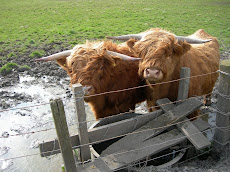Murder, mayhem and Mons Meg dominate the history of a simple tower house perched on an island in the River Dee, near Kirkcudbright. Threave Castle served the "Black" Douglases, who used this watery site as a springboard against their rivals, the Stewarts, in the 14th and 15th centuries. As the typical Scottish tower house, the stronghold effectively merged simplicity and durability to pose a formidable threat to all comers.
Archibald the "Grim", Lord of Galloway and 3rd Earl of Douglas, erected Threave Castle in 1370 on the site of an earth-and-timber fortification. The illegitimate son and only heir of "Good" Sir James Douglas, Archibald developed a reputation in Galloway for cold-hearted oppression. Isolated from the surrounding landscape, this inhospitable tower house seems an appropriate home for the despised Archibald, yet the structure was more elaborate than its exterior suggests.
Standing five storeys high, the 8-foot thick walls solidly protected the Douglases. Each story had a specific purpose. Used for storage, the vaulted basement contained the well, a sink and drain and the dungeon. It may also have held servants quarters. The kitchen level above the basement had a large fireplace, stone sink, deep recessed window, latrine and probably provided dining space for the servants. A spiral staircase afforded the easy transfer of hot meals between the kitchen and the great hall, purposely located on the floor above. As the Laird's showplace, the great hall featured an ornate fireplace, three well-lit windows with seats and a latrine. An outside doorway allowed passage between the great hall and boat docks on the river below. Archibald and his descendents lived on the floor above the great hall, with private apartments offering refuge and a bedchamber when guests proved tiring. Meager accommodation filled the uppermost storey.
After the death in 1439 of the powerful 5th Earl of Douglas, who was also named Archibald, the relationship between the Black Douglases and the Scottish monarchy, which had never been easy, began to break down. In 1440, the two Douglas heirs, William and David, rode to Edinburgh Castle to dine with King James II, who was still in his teens. During the "Black Bull's Dinner", the kings regents charged the young Douglases with treason. According to tradition, at the end of the evening's meal, one of the regents placed a bull's head before the brothers to symbolize their impending doom. Both were executed in front of the young king.
The blood feud continued. In 1452, the 8th Earl imprisoned a rival, Sir Patrick MacLellan, who was "the Tutor of Bombie" and Sheriff of Galloway. MacLellan's uncle visited Douglas, who suspected the uncle was carrying a release decree signed by the king. Douglas arranged to dine with the uncle before discussing the prisoner's freedom. During the meal he had MacLellan killed, voiding the royal decree and enraging King James.
The king soon discovered that Douglas was conspiring against him with the Earl of Crawford and the Lord of the Isles, John MacDonald. Allegedly hoping to reconcile the bad blood between them, King James II invited Douglas to dine at Stirling Castle. When the 8th Earl of Douglas refused to renounce his association with Crawford and MacDonald, the king became infuriated and stabbed him to death.
In 1455, the king's army defeated James, 9th Earl of Douglas; and his assembly of 40,000 men, who marched to Stirling Castle to avenge the murder of the 8th Earl. Proceeding to Threave, James II scorned the Earl's offer of the castle as a gift and instead built an artillery wall around the stronghold. The king then bombarded the sturdy tower house with the legendary Mons Meg (how housed in Edinburgh Castle). The Mons Meg was a mammoth cannon presented by the Duke of Burgundy to James II in 1457. Seeing the destruction of several outbuildings and with their laird safely ensconced in England, the garrison surrendered to the king. From then onward, Threave Castle served as a royal fortress with the Lords Maxwell as hereditary keepers from 1526.
The castle of the Black Douglases faced its final and most devastating siege in 1640, when a force of Covenanters, Calvinists determined to enforce Protestant rule in Scotland, wreaked havoc upon the site for 13 weeks. Although left in ruin, the tower house remained strong enough to imprison French prisoners during the Napoleonic Wars.
In 1948 the National Trust for Scotland became custodians and started a School for Practical Gardening in the castle grounds. Now under the dual care of the National Trust for Scotland and Historic Scotland, Threave Castle is open during the summer for an entrance fee.
Michael Russell Your Independent guide to Tourism [http://tourism-guided.com]
Article Source: http://EzineArticles.com/?expert=Michael_Russell
Michael Russell - EzineArticles Expert Author
Saturday, 22 May 2010
Scotland - Threave Castle By Michael Russell Platinum Quality Author
Labels:
Scotland - Threave Castle
Subscribe to:
Post Comments (Atom)











No comments:
Post a Comment